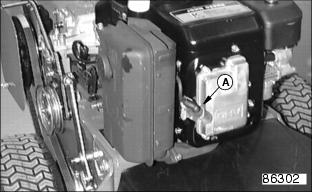Introduction
Safety Signs
Controls
Operating
Replacement Parts
Service Machine Safely
Service Interval Chart
Service Engine
Service Engine
Engine Warranty Maintenance Statement
Cleaning And Gapping Spark Plug
Checking And Cleaning Air Cleaner
Service Transmission
Service Steering & Brakes
Service Mower
Service Electrical
Service Miscellaneous
Troubleshooting
Storing Machine
Assembly
Specifications
Warranty
Service Literature
Copyright© Deere & Company

Service Kawasaki Engine
Engine Warranty Maintenance Statement
Maintenance, repair, or replacement of the emission control devices and systems on this engine, which are being done at the customers expense, may be performed by any nonroad engine repair establishment or individual. Warranty repairs must be performed by an authorized John Deere dealer.
Adjusting Carburetor
NOTE: The carburetor is calibrated by the engine manufacturer and should not require any adjustments.
NOTE: If engine is operated at altitudes above 1829 m (6,000 ft.), some carburetors may require a special high altitude main jet. See your John Deere dealer.
NOTE: Possible engine surging will occur at high rpm when the transmission is in neutral ("N") and the PTO switch is in the OFF position. This is a normal condition due to the emission control system.
If engine is hard to start or runs rough, check the Troubleshooting section of this manual.
After performing the checks in the troubleshooting section and your engine is still not performing correctly, contact your John Deere dealer.
Avoid Fumes
· If it is necessary to run an engine in an enclosed area, use an exhaust pipe extension to remove the fumes. |
Engine Oil
Use oil viscosity based on the expected air temperature range during the period between oil changes.
The following John Deere oils are preferred:
The following John Deere oils are also recommended, based on their specified temperature range:
· TORQ-GARD SUPREME® (SAE 5W-30)
Other oils may be used if above John Deere oils are not available, provided they meet one of the following specifications:
· SAE 10W-40-API Service Classification SG or higher
· SAE 10W-30-API Service Classification SG or higher
· SAE 5W-30-API Service Classification SC or higher
Checking Engine Oil Level
Service Interval: Check oil level on a daily basis.
1. Park mower on a level surface. Stop engine.
2. Remove dipstick (A). Wipe it clean.
3. Install dipstick in tube, but DO NOT tighten it. Let dipstick threads rest on top of tube.
4. Remove dipstick. Check oil level. Oil should be between ADD and FULL on dipstick.
5. Add oil if necessary. (See Engine Oil in this section for correct oil.)
6. Install and tighten dipstick.
Changing Engine Oil
IMPORTANT: Avoid damage! To help prevent damage to engine: · Change oil and filter after first 25 hours of operation. (See Service Interval Chart for remaining intervals.) |
1. Park mower on a level surface. Stop engine.
· Put container under drain tube (A).
· After oil drains, tighten plug.
4. Add oil slowly into dipstick tube:
5. Wipe dipstick with clean rag.
IMPORTANT: Avoid damage! To help prevent damage to engine when you mow on slopes, add oil to FULL level. |
6. Install dipstick. Let it rest on threads.
7. Check oil level.Remove dipstick and check oil level: Oil must be between ADD and FULL.
Changing Engine Oil Filter
IMPORTANT: Avoid damage! To help prevent damage to engine, change oil and filter after first 25 hours of operation. (See Service Interval Chart for remaining intervals.) |
· Put small container under filter to catch draining oil.
· Turn filter counterclockwise to remove it.
· Remove rubber seal with filter.
2. Put film of clean engine oil on seal of new filter.
· Turn filter until seal contacts mounting surface.
· Then turn filter BY HAND 1/2 turn more.
4. Run engine to fill filter with oil and check for oil leaks.
5. Check oil level, add oil as required. (See Engine Oil in this section for correct oil.)
Cleaning And Gapping Spark Plug
Service Interval: Clean and gap spark plug every 100 hours of operation.
1. Clean area around spark plug.
2. Disconnect spark plug wire (A).
3. Remove and inspect spark plug:
· Clean plug and check for damage, replace if necessary.
· If plug is in good condition, check gap.
4. Check and adjust spark plug gap (B), gap should be 0.76 mm (0.030 in.)
5. Install spark plug and tighten to 20 N·m (15 lb-ft.).
Checking And Cleaning Air Cleaner
· Operating in dusty conditions may require daily maintenance.
· Clean foam element every 25 hours of operation.
· Clean or replace paper element every 100 hours of operation.
1. Remove two bolts (A) and air cleaner cover (B).
2. Foam element (C) - Clean every 25 hours of operation:
· Wash in detergent and water.
· Saturate in clean engine oil and squeeze out excess.
3. Paper element (D) - Clean or replace every 100 hours of operation:
· If paper element is dirty, tap gently on your hand to remove dust.
· If paper element is extremely dirty, install new element.
4. Install cleaner cover and fasten with two bolts
Replacing Fuel Filter
· Operating in dirty conditions may require more maintenance.
· Replace fuel filter every 100 hours of operation or annually.
1. Park tractor on a level surface.
3. Turn fuel shut-off valve to the CLOSED (OFF) position. (See Fuel Shut-Off Valve in Operating section.)
4. Slide hose clamps (A) away from filter (B).
5. Place a drain pan under hoses to catch any fuel that maybe left in the hoses.
6. Disconnect hoses from filter.
7. Install new filter. Be sure filter is located with arrow pointing in direction of fuel flow.
8. Connect hoses to new filter.
10. Turn fuel shut-off valve (A) to the OPEN (ON) position. (See Fuel Shut-Off Valve in Operating section.)









